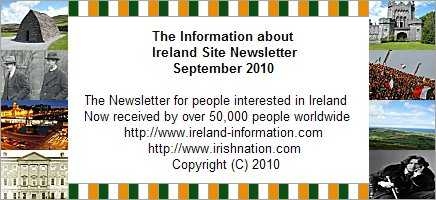
===========
IN THIS ISSUE
===========
=== News Snaps from Ireland
=== New free resources at the site
=== The Vikings in Ireland
=== Seven Churches by Pat Watson
=== A Dream Trip to Paradise by Olivia Mendez
=== Irish Festival & Clan Gathering Noticeboard
=== Gaelic Phrases of the Month
=== Monthly free competition result
==========
FOREWORD
==========
We hope you are enjoying the new HTML format of
your Ireland information newsletter. It really is
true that a picture is worth a thousand words so we
will continue to improve the format. Let us know
what you think!
We have an article about the Vikings in this month's
edition as well as another great tale from Pat Watson.
Enjoy!
Michael
Help keep this newsletter alive at
www.irishnation.com
WE NEED YOUR HELP!
PLEASE - send this newsletter on to your friends
or relatives who you think are interested in
Ireland. By doing this you are helping to keep
us 'free'.
Got something to say? Don't keep it to yourself!
Why don't you submit an article for inclusion
in the next edition? Go here for more information:
https://www.ireland-information.com/newsletter.htm
Do you have access to a website? You can help to
keep this newsletter alive by adding a link to
any of our websites below:
https://www.irishnation.com
http://www.irishsurnames.com
https://www.ireland-information.com
http://www.allfamilycrests.com
http://www.irishpenpals.com
If you have an AOL or HOTMAIL account then you
may get better results by viewing this
newsletter online here:
https://www.ireland-information.com/sep10.htm
The only way that you could have been
subscribed to this newsletter is by filling
out a subscription form at the site whereupon
a confirmation notice would have been issued.
If you wish to unsubscribe then go here:
https://www.ireland-information.com/newsletter.htm
========================
NEWS SNAPS FROM IRELAND
========================
OPINION POLLS CONTINUE TO SHOW THE RISE OF LABOUR
The end of 'civil-war' politics in Ireland may be
upon us. The 1921 Anglo-Irish Treaty was followed
by a civil war in Ireland with the Irish Free
State led by Michael Collins eventually triumphing
over Eamon deValera's rebels. The two factions
went on to form Fine Gael and Fianna Fail, the two
parties that have dominated Irish politics ever
since. They did so at the expense of a Labour
Party that is only just now recovering.

There has never been a Labour Party Taoiseach
(Prime Minister) but there is a real possibility
that that could change after the next general
election (to be held no later than 2012). While
Fine Gael have certainly enjoyed a big bounce in
support during the last few years of a disastrous
economy it is Labour who have profited most from
the financial and economic meltdown. They have
gained as much support as Fianna Fail has lost
with the current ruling party of deValera facing
decimation in the next election. It is no wonder
they are desperate to serve out their full term in
office while hoping that the economy recovers. If
the election were held today it is certain that
Fianna Fail would trail in in third place among the
popular parties.
Labour are led by Eamon Gilmore who has
repeatedly ranked as the most popular of all of
the party leaders. They have been criticized for
not stating enough specific policies while being
only too eager to criticize the policies of the
Fianna Fail and Green Party coalition. Nevertheless
it is clear that there is a seismic shift about to
occur with the demise of the 'Celtic Tiger' marking
the moment for Labour to emerge from its
near-century long slumber.
Fine Gael supporters must be on the one hand bemused
and frustrated with these developments while on
the other hand very unhappy with their own leader.
Enda Kenny survived an attempted ousting earlier
this year and was able to put his party opponents
in their place. He has failed to convince the
voters though that he would make a good Taoiseach.
Despite a dreadful economy and a deeply unpopular
government Fine Gael has still failed to really
capitalise despite the very best of political
conditions. The blame lies with their party leader
who at times appears unable to effectively convey
his message while also exercising poor political
judgement.

For Fianna Fail then it is a matter of holding on
in government as long as possible while hoping that
the economy turns. They are certainly going to be
severely thumped in the next election whenever it
is held. Is there a possibility they could still
stay in government? If Fine Gael get more seats
than Labour (which was 'likely' and is now only
'possible') with Fianna Fail in third place would
Fine Gael be willing to offer Labour a role as
Taoiseach on a time-share basis? Fianna Fail
certainly would.
It seems that if Eamon Gilmore wants to be
Taoiseach all he has to do is insist on it during
the post-election negotiations. Truly that would be
the end of 'civil war' politics in Ireland.
EMIGRATION AT 20-YEAR HIGH
The worsening economy has again raised the spectre
of emigration in Ireland with workers fleeing to
the UK, Australia, USA and Canada in search of a
new life. Excluding non-nationals who moved into
Ireland during the boom years and who are now
returning home the number of Irish citizens leaving
has risen dramatically to over 27,000 annually, up
by 42% on 2008.
UCD AND TCD IN WORLDS TOP 100 UNIVERSITIES
Two Irish Universities have ranked in the 'Times
Higher Education 2010-11 World University
Rankings'. Trinity College Dublin (TCD) is ranked
76th while University College Dublin (UCD) is
ranked in 94th place.

IRELAND NOT REALLY THE SECOND RICHEST!
You would not think it to read the newspapers or
view the television reports with every second story
being gloom and every other story being doom but
Ireland is still tops in the 'rich-list stakes.
Well, not really. The 'Measuring Ireland's Progress
2009' by the state-run Central Statistic Office's
does place Ireland as second only to Luxembourg in
terms of GDP per capita. But when GNI (Gross
National Income) is measured Ireland's ranking
falls dramatically to tenth place in the EU,
perhaps a much more accurate picture of the
economic reality.

The report also highlighted the spiralling cost of
the banks bailout and the real cost of failing to
reform the public service. State debt has surged
from 25% to 64% of GDP over the last two years.
The EU average is 74%!
Irish workers were recorded as being one third
more productive than their EU counterparts partly
because they work longer hours. Unemployment at
12% in 2009 was the sixth highest in the EU.
The divorce rate was the lowest in the EU, the
birth rate the highest and we have the youngest
population. Over 45% of young people (aged 25 to
34) have a higher level qualification, ranking the
country the second highest in the EU.
MAJOR VIKING SETTLEMENT FOUND IN COUNTY LOUTH
An ancient Viking settlement dating from the year
941 has been discovered at Annagassan, in County
Louth. It is thought to be the fortress of
Linnduchaill, one of the Viking's Winter respites
and is a location that rivalled Dublin with the
eventual capital city dominating due to its
deeper water harbour.

Voice your opinion on these news issues here:
https://www.ireland-information.com/newsletterboard/wwwboard.html
=============================
NEW FREE RESOURCES AT THE SITE
=============================
IRISH HOLIDAY AND TOURIST FORUM
Post your question about holidaying in Ireland and
we guarantee an answer will be posted on the board:
https://www.ireland-information.com/irishholidays-irishtourist/irishtouristboard.html

IRELAND HOUSE-SWAP LISTING
We are working on the online program to allow you
to freely add and view details of other people who
are interested in this service.
You can add your home-swap details to our new free
listing service at:
https://www.ireland-information.com/irelandhouseswap.htm
NEW COATS OF ARMS ADDED TO THE GALLERY
The following 5 coats of arms images and family
history details have been added to the Gallery:

G: Gallen
H: Harding, Hussey
P: Pell, Preston
View the Gallery here:
http://www.irishsurnames.com/coatsofarms/gm.htm
THE PERFECT WEDDING, ANNIVERSARY OR BIRTHDAY GIFT!
We now have over 100,000 worldwide names available.
Get the Coat of Arms Print, Claddagh Ring,
Screensaver, Watch, T-Shirt Transfer or Clock for
your name at:
https://www.irishnation.com/familycrestgifts.htm
YOU CAN HELP TO KEEP THIS FREE NEWSLETTER ALIVE!
Visit: https://www.irishnation.com
where you can get great Irish gifts, prints,
claddagh jewellery, engraved glassware and
much more.
Anne MacDonald of Massachusetts, USA ordered
a family crest plaque:
Hello, Michael,
Received my plaque, carefully wrapped,
in good order. It is splendid! I am
thrilled, and I know that my dad, for whose
81st birthday this was ordered, will love
it. I would like to order another one!
Everyone who has seen the plaque has been
really impressed, even those who, as my
daughter says are 'not into ancestor
worship!'Again, my hearty thanks for this
first-class product.
Sincerely, Anne MacDonald

THE PERFECT WEDDING OR ANNIVERSARY GIFT!
View family crest plaques and shields here:
https://www.irishnation.com/familycrestplaques.htm
====================
THE VIKINGS IN IRELAND
====================
The history of the Vikings in Ireland stretches
back to the eight century and culminates with
their defeat by Brian Boru at the Battle of
Clontarf in the year 1014.
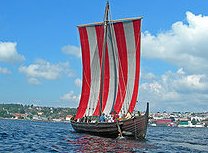
The earliest recorded raid from Vikings out of
Norway was in the year 795 at Rathlin Island
off County Antrim. The Scottish isle of Iona
was also attacked in the same year, the
monasteries plundered and burned. By the year 802
the raids had stretched around the western coast
as far as Skellig island and the ancient monastery
there. By the year 832 an intensification of the
attacks occurred with fleets of Viking ships
arriving at the Boyne, at Dublin and travelling
the Shannon estuary. They took supplies, riches
and slaves. They over-wintered for the first time
in the year 840 settling at Louth and Dublin,
using these bases for further attacks along the
coast. The word Viking is taken from the Norse
word 'Vikingr' which means 'sea-rover' or 'pirate'.
Their longboats gave them an advantage that other
sea-faring peoples just could not match. Their
fierce attacks must have instilled terror into
the local population and especially at the
monasteries where much of the wealth they craved
was located. It is no coincidence that the number
of high-towers built for protection in Ireland
greatly increased during this era.
The Irish chieftains now began their defence in
earnest since, as the Vikings had begun to make
semi-permanent settlements they had become a
much easier target. The Irish chieftain Máel
Seachnaill is recorded as having routed the
Vikings at Skreen in County Meath, putting over
700 of the invaders to death. Alliances between
the Vikings and the Irish chieftains became
commonplace as the presence of the norseman
became a political inevitability to be
acknowledged and dealt with.
By the year 849 invaders from Denmark had begun
to attack not only the Irish but also the more
established Vikings of Norwegian origin. By
853 'Olaf the White' had assumed control of
Dublin. He married the daughter of Áed Finnliath,
king of the northern Uí Néill. Decades of warfare
with some victories and some defeats for the
Vikings followed. In the year 902 the Irish
defeated the Vikings at Dublin.
A second wave of attacks began in the year 914
with a large fleet of Vikings ravaging Munster.
Over time the Irish fought back with some success.
The Dublin Vikings were attacked by the King of
Tara, the city sacked in the year 944.
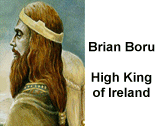
The stage was set for a great showdown between
the two cultures with Brian Boru of Dál Cais
in County Clare being the spear-point of the
Irish attack. He had already defeated the Vikings
in Munster. His great rival was Máel Sechnaill II,
King of Tara. They reached an accord in the year
977 that Brian Boru would rule the southern part
of the country with Máel Sechnaill II ruling the
northern part. They even collaborated on a raid
against the Dublin Vikings in the year 998. By
the year 1000 Brian Boru had put down a revolt by
the Dublin Vikings, defeating Sitric and
eventually forcing Máel Sechnaill II to
acknowledge him as the High King of all of Ireland.
The Leinster Vikings again revolted in the year
1012 but were once again defeated. They knew that
their time was limited so they sought help from
Sigurd, Earl of the Orkneys, who arrived in the
early part of 1014 to face the Irish.
The famous battle of Clontarf ensued with the
Irish squaring up to Sigurd, Brodar and Ospak
who were Vikings of the Isle of Man. With
Brian Boru, Brodar and Sigurd all killed in the
fierce battle that followed the Vikings were
eventually defeated, the battle entering the
pantheon of myth and legend of Viking history.
Estimates of the number of dead range from 6000
to over 12000, a huge number for warfare of
that time. The Viking defeat at the battle of
Clontarf effectively signalled the end of Viking
rule in Dublin and thus throughout the country.
Long before this battle though the inevitable
integration of the two cultures had begun. The
invaders even assimilated the native Christian
religion, forming alliances, marrying and
eventually settling among the native Irish.
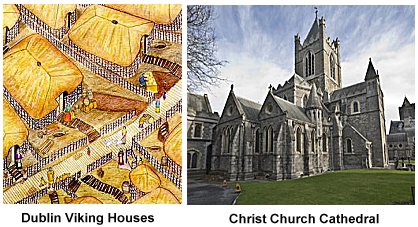
The legacy of the Vikings in Ireland is extensive.
The towns of Dubin, Cork, Wexford, Limerick and
Waterford that were initially founded by the
Vikings all developed into the major cities of
the modern era. A full-scale invasion of the
island was never attempted as the Vikings had
matters in England and France to deal with.
Thus, despite the attacks, the native Irish
chieftains continued to prosper and make
treaties, war with each other and the Vikings,
sometimes allying with the 'norsemen' against
rival chieftains.
Coinage was first used in Ireland during the
Viking era further providing evidence of the
degree to which the Vikings changed from being
raiders to merchants and settlers. Dublin was
especially transformed by their presence, with
Christ Church Cathedral being built by Sitric.
The layout of the city centre today is much as
it was originally designed by the Vikings. Further
proof of their integration survives the centuries
through the use of surnames. Families of
McAuliffe (son of Olaf), McManus (son of McManus),
Doyle (the dark stranger or foreigner),
McLoughlin (son of Lochlainn) and McIvor (son of
Ivor) are just a few of the many 'Irish' names
that have deep roots within the Viking heritage.
The death of Brian Boru marked a period of further
fighting among the native Irish culminating with
the Anglo-Norman invasion in the year 1169 and
the beginning of a new period of warfare. It is
a tragic fact of Irish history that the various
chieftains and tribes remained so divided,
unwilling to create a central leader or kingship
capable of unifying opposition on the island to
the centuries of invasion that were to follow.
KEEP THIS NEWSLETTER ALIVE!

Get Your Family Crest Signet Ring at:
https://www.irishnation.com
============================
'SEVEN CHURCHES' by Pat Watson
============================
The ramblers in our house used to tell of the great
patrons of Seven Churches. Seven Churches was the
local name for Clonmacnoise, which, although only
about eight miles away, was in a different parish,
a different diocese, a different county, a
different province and the other side of the river
Shannon in what the old people called The Kings
County. Yet we knew all about the goings on there,
on patron Sunday, the Sunday nearest the ninth of
September, the great gathering of young people,
the trick-of-the-loops, the three card trick men,
various sellers of artefacts, religious and
otherwise, the occasional frog thrown on to
gaming tables or to unwelcoming girls, and the
whispering arch.
In the fifteenth century, Dean Odo Malone
installed a very elaborate cut-stone doorframe
in the north door of the cathedral. This frame
has seven or eight, sort of half pipes, cut
into the stone, right around the arch and they
can clearly carry a whisper all the way round
to the other side. They will not carry a voice.
My mother often told of half a dozen girls on
one side whispering to a similar number of boys
on the other side. The problem was that you
could never be sure who would pick up your
message, as you had to lean right into the arch.
The people on the other side held their ears to
the arch and they could see the speakers. I
suppose it was the texting of the time.
'How would you like to be buried with my people?'
or 'The back of your head is looking good'.
A genuine marriage proposal made here carried
great luck. The snag was that different pipes
carried different blessings such as, a large
family, a small family, mostly boisterous boys,
all girls or a priest in the family and other
things best not talked about. Nobody knew which
was which but the good outnumbered the bad.
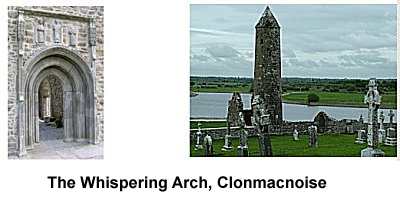
It seemed that the pipe with the large family
was mostly used, as nearly all family were large
then. Perhaps it was the middle one that carried
the whisper the clearest or maybe it made a
difference whether it was the man or the woman who
initiated the whisper. Some people thought it was
the colour of the hair of the second speaker but
that could not be right either as families were
large regardless. However one thing was certain,
no whisperers wound up alone! The arch is still
there so if you fancy your chances, just go along
and wait until a suitable looking partner is
passing and whisper your piece.
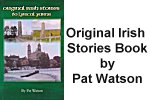
'Seven Churches' is one of sixty lyrical yarns from
'Original Irish Stories' by Pat Watson,
Creagh, Bealnamulla, Athlone, Ireland.
First published in May 2006.
Visit: http://www.myirishstories.com
or you can email the author here:
pjwatson@utvinternet.com
KEEP THIS NEWSLETTER ALIVE!

Get Your Family Crest Flag at:
https://www.irishnation.com
=======================
A DREAM TRIP TO PARADISE
=======================
For many years I have been wanting to get to
Ireland. My family is not Irish, my native language
is not English and the traditions in my country are
different from the Irish. Nevertheless, I have been
so attracted to the 'green island' that I learned
something of its history, traditions and tales,
have enjoyed the music and dancing, and even have
learnt and read great Irish poets and writers,
the best in the English language I would say.
After finishing my English Degree, I went into the
Yeats Summer School in Sligo. One reason was to
learn more about this amazing poet, but the most
important reason was to finally meet Ireland in
person.
I arrived in Dublin at the end of July and had
little chance to go around the city centre, since
I had to register at the Yeats Society two days
later. Fortunately I booked a central hotel in
order to have more time to go around. The
O'Connell Street is amazingly wide! It is a very
busy street and with so much history on it. The
river and the bridges give a romantic site to
this modern and at the same time traditional
city. When getting to the Trinity College, wow!
it is like being in a different town, in a
different world! You would really love to study
there! Beautiful old buildings, full of history,
culture and art. I went to the Gallery, the
Writers Museum, but there were many other places
I did not have the chance to see for lack of time.
One day later I was taking the train towards
Sligo, crossing the whole island to the northwest.
This is, I believe, a very good choice in order
to get to know the country sights, the way people
in the different counties live. You can see lots
of cows, sheep, and horses. Beautiful farms and
lots, lots of green, green everywhere!
Sligo is a small beautiful town, the people there
are very proud of the Yeats' inheritance. Most of
them have something to tell you about William
Butler Yeats, about the places he lived at and
wrote about in not few of his poems. They are
always willing to help you find the right spot
for a photograph, or the right place to learn
more of the town and the surroundings.
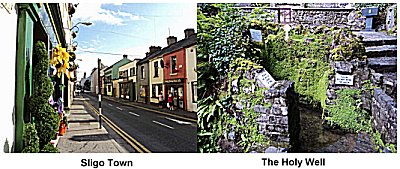
Knocknarea and Ben Bulben are huge mountains that
seem to be keeping this little town, protecting
it from the strong winds and the Atlantic Ocean.
Although very tall, they can be climbed, and it
is worth doing because when arriving at their
top, the gift of having the chance to appreciate
all the wonderful land below is priceless.
Carrowmore megalitic cemetery and the other
megalitic centres have a tight relation with
Knocknarea which has a large tomb at the top.
They all are geometrically connected for some
reason the archaeologists still cannot figure out.
Under Ben Bulben (as the title in the poem),
at Drumcliff, lies the Yeats' grave, and one of
the most ancient Celtic crosses on the island.
This beautiful land is full of lakes, rivers,
streams, falls and wells.
Lough Gill with its tiny islands, like Innisfree,
is just a few minutes drive from town. The
Garavogue river passes across the town and you
can find lots of beautiful swans peacefully
swimming in its waters. Glenndale Falls make you
feel like being in a fairy tale, as much as the
Holy Well, where any religion or kind of faith
can be worshiped, after all, it's nature of the
one who hold us all and protects us.
There are so many things to do and visit in the
western coast of Ireland you would need months
to really get to know it, appreciate it, and
breathe it in all its splendor.
I am very proud to have accomplished my dream of
going to this beautiful country, my version of
paradise.
Olivia Mendez
Mexico City, Mexico

==========================================
IRISH FESTIVAL & CLAN GATHERING NOTICEBOARD
==========================================
THE HALPIN REUNION AT MILWAUKEE IRISHFEST
Hi Michael,
The reunion was enjoyed and I have already been
requested to plan/organize another for next summer
- so I have already begun on that. Everybody loved
the flags you made for us- and many did not get
one this year that are saying that they want one
definitely for next year.
John Seitz - Halpin Clan Gathering organiser
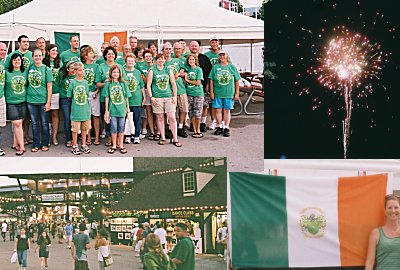
If you have an Irish festival or
event or a clan gathering notice
you would like included in the
newsletter do contact us at:
https://www.ireland-information.com/aboutus.htm
===========================
GAELIC PHRASES OF THE MONTH
===========================
PHRASE: Is fhearr fheuchainn na bhith san duil
PRONOUNCED: iss far vue-chonn nah vith san du-ill
MEANING: It is better to try than to hope
PHRASE: Tada gan iarracht
PRONOUNCED: taw-dah gonn ear-ockt
MEANING: Nothing is done without effort
PHRASE: Cha d'dhùin doras nach d'fhosgail doras
PRONOUNCED: caw dih-doo-inn durriss nock dus-gall duriss
MEANING: No door closed without another opening
View the archive of phrases here:
https://www.ireland-information.com/irishphrases.htm
==================
COMPETITION RESULT
==================
The winner was: telelarmana@hotmail.com
who will receive the following:
A Single Family Crest Print (decorative)
(US$19.99 value)

Send us an email to claim your print, and well done!
Remember that all subscribers to this
newsletter are automatically entered into the
competition every time.
I hope that you have enjoyed this issue.
Until next month,

Michael Green,
Editor,
The Information about Ireland Site.
https://www.ireland-information.com
Click here to contact us